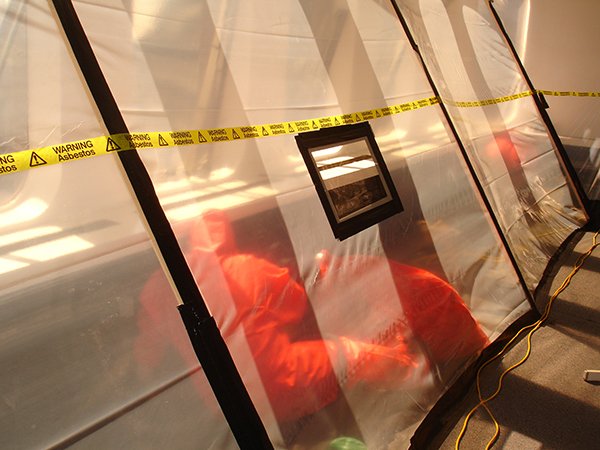 By Paul Clarke-Scholes of Clifford Devlin.
By Paul Clarke-Scholes of Clifford Devlin.
Asbestos removal enclosures use polythene for the main containment walls and tape, glue and foam to fix the polythene to the existing structure and to seal any gaps. Occupants as well as clients are often unaware of what is involved and are surprised when damage is caused to the decorative order.
We have even had cases where a tenant has spent several hundred pounds on wall coverings. To cause even minor damage to these would be clearly unacceptable. And yet, to risk conducting asbestos removal without a robust enclosure is to risk exposing persons to asbestos dust or contaminating an entire property.
As with all asbestos related matters, planning is the solution. The properties need to be assessed and such problems identified well in advance of the removal team’s arrival.
There are a number of techniques that can be used, but they can only be successfully implemented with prior warning, ensuring that the removal team are aware of the problem, have the right materials with them and perhaps most importantly, the time to spend arranging something slightly out of the ordinary.
The standard approach is to secure the polythene to a wall with a cloth tape designed to have an “aggressive” adhesive in order to minimise the risk of the sheeting coming loose during removal, thus spreading asbestos fibre across the property. If the walls are in poor condition we use an aerosol adhesive to make sure that the tape sticks. When we dismantle the enclosure, either the tape/glue combination removes the paint or paper on the walls or the glue leaves a residue.
The simplest solution is to warn the occupants what to expect (i.e. managing their expectations) and to allow for the costs of redecoration. In many cases this is readily feasible as the asbestos removal is being conducted as part of a planned refurbishment and all such costs are already included.
The problems arise where, for instance, a kitchen is being refurbished but the airlocks are installed in the hall and the wallpaper and painted surfaces there get damaged. We prefer to fix tape to timber, painted surfaces, as it sticks much better. If a clean timber surface is available, we are usually going to make use of it, but the tape may still leave marks that need sanding off before repainting.
We often use frames to form airlocks, but as these are one metre square, they wont go through a standard door after being wrapped in polythene. Recently there are sectional airlocks that can be adjusted to suit properties with narrow hallways and landings, but we still need a good sized space to build these, at least 4 metres by 3 metres.
We can also use timber members wedged at a suitable point, say between two walls using correx sheeting to protect the wall. An experienced operative will also know how to lap the polythene so that the majority if not all the taped joints are on the inside and the polythene is not fixed to the existing structure at all. The way to ensure that a skilled operative is present is to ensure that your Licenced Asbestos Removal Contractor is pre-warned.
Paul Clarke-Scholes is an asbestos consultant with contractor Clifford Devlin.
This is the ninth of a series of blogs which discuss the latest issues in asbestos management – next week Paul explains some of the pitfalls involved in using external enclosures or “goldfish bowls”.
What makes us susceptible to burnout?
In this episode of the Safety & Health Podcast, ‘Burnout, stress and being human’, Heather Beach is joined by Stacy Thomson to discuss burnout, perfectionism and how to deal with burnout as an individual, as management and as an organisation.
We provide an insight on how to tackle burnout and why mental health is such a taboo subject, particularly in the workplace.



[…] Asbestos removal: internal tents – The standard approach is to secure the polythene to a wall with a cloth tape designed to have an “aggressive” adhesive in order to minimise the risk of the sheeting coming loose during removal, thus spreading asbestos fibre across the property. […]
[…] Asbestos removal: internal tents – Asbestos … removal is being conducted as part of a planned refurbishment and all such costs are already included. The problems arise where, for instance, a kitchen is being refurbished but the airlocks are installed in the hall and the wallpaper and … […]
[…] Asbestos removal: internal tents – Asbestos removal enclosures use polythene for the main containment walls and tape, glue and foam to fix the polythene to the existing structure and to seal any gaps. Occupants as well as clients are often unaware of what is involved and are surprised when … […]
[…] Asbestos removal: internal tents – The way to ensure that a skilled operative is present is to ensure that your Licenced Asbestos Removal Contractor is pre-warned. Paul Clarke-Scholes is an asbestos consultant with contractor Clifford Devlin. This is the ninth of a series of blogs which … […]